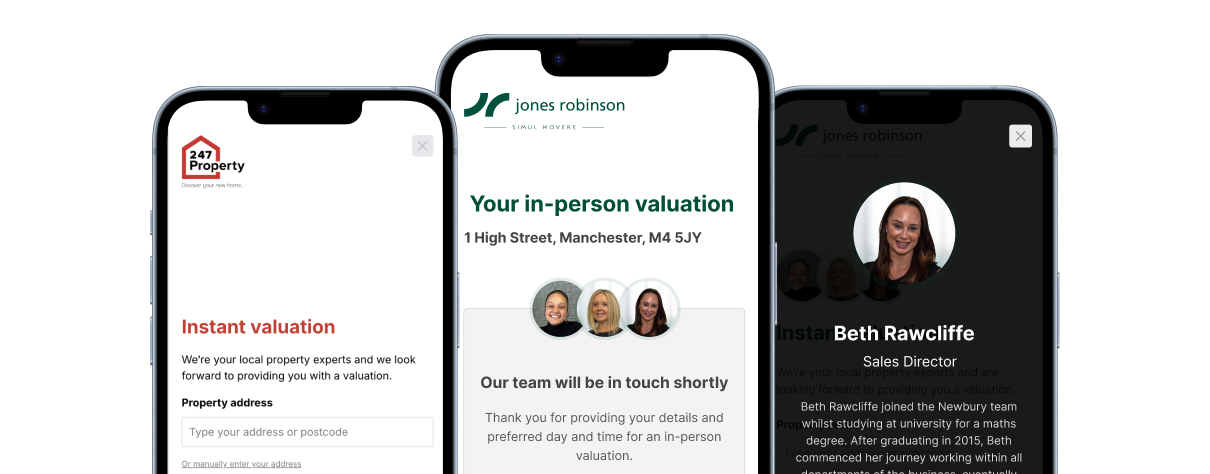Call Us: 020 7801 9875

Welcome to our in-depth guide to help you understand and make the most of online valuation tools.

An online valuation tool is a small piece of software — often a pop-up, widget, or embedded page — that sits on an estate agent’s website. Its job is to give users a quick, automated estimate of their property's value, based on their address and a few simple inputs.
The journey usually takes the user through three or four steps:
Behind the scenes, this process is powered by an Automated Valuation Model (AVM) — a set of algorithms that crunch data from sources like the Land Registry and recent sales to produce a ballpark figure.
From the agent’s perspective, these tools are about more than just giving a valuation. They’re designed to tease users into identifying themselves as potential sellers or landlords — and turning anonymous website visits into genuine leads.
Most AVMs use data from the UK Land Registry. They identify when a property last sold, how much it sold for, and what similar properties in the area are currently worth. They then use an algorithm to apply inflation trends or local market shifts to estimate today’s value.
Some tools allow the user to input extra data to refine the estimate — for example, whether the home has been modernised, how many bedrooms it has, or its current condition.
Accuracy varies. The more recent and comparable the data, the better the result. But no AVM can account for the full nuance of a property’s condition, layout, or local quirks — which is why they’ll never fully replace in-person valuations.
Let’s be blunt: they’re not as accurate as a human valuation from a good local agent. They can’t account for the things that matter — like whether the kitchen’s been refurbished, if there’s a new school down the road, or if the property’s had a side return extension.
There are also risks of mismatching the exact property, especially in flats or subdivided buildings.
However, most users understand that an instant online valuation is an estimate, not a professional opinion. It’s a teaser, not a commitment — and that’s where its value lies.

The primary reason to use an online valuation tool is to increase lead generation — by making it easier for website visitors to raise their hand and signal that they’re thinking of selling.
It’s the difference between offering:
That difference in tone lowers the barrier to engagement and pulls in users who are earlier in their decision-making journey.
Think of it like chocolate vs cheese at a dinner party: the instant valuation is tempting, low-commitment, and fun — but still gets people to the table.
Yes, they often do — though not all leads are equal.
Online valuation enquiries may skew toward people earlier in the selling cycle. They’re curious, maybe not ready to list just yet. But they’re also in play, and that early interaction gives you a chance to build a relationship before a competitor does.
In practice, instant valuations tend to:
On many websites, around 40% of all valuation enquiries may come through the instant route — though results vary by region, brand, and implementation.
The best-performing tools are simple, slick, and on-brand. They:
User psychology matters. If the interface is friendly, trustworthy and friction-free, users are more likely to complete the process and give real contact information.

Here’s a quick checklist of ways to promote an instant valuation on your website. We also have a more comprehensive list for you to explore.
And remember to promote it beyond your website. We have another longer checklist for this too, but be sure to include:
If you've made the decision to use instant valuations to increase the leads from your website, be sure to avoid some common slip-ups:
Remember: the goal is to attract and engage curious vendors, not put them off. Keep it simple, human, and responsive.
They appeal most to the curious — often homeowners at the start of their selling journey. That means they may not be ready to instruct straight away, but you’ve got in early. You’re building awareness and rapport before anyone else does.
They’re less likely to appeal to seasoned developers or vendors who already have a good sense of value. But for the general public, they’re a great entry point.
Online valuation tools help independents stay competitive with larger national chains or online agents, who often have slicker tech stacks. Having one shows you’re modern, responsive, and easy to engage with.
And paired with good SEO or pay-per-click advertising, they can become a cornerstone of your lead generation strategy — helping you attract, convert, and manage seller enquiries more effectively.
The tech is evolving fast. Expect to see:
Ultimately, online valuation tools are becoming part of a bigger picture — a full digital journey from curious homeowner to instructed seller, with your agency at the centre.
If you’re hesitant about offering online valuations, ask yourself this: would you rather have the lead or not? They won’t replace human valuations — and they don’t need to. Their job is to open the door.
Used thoughtfully, they can help you get more enquiries, start more conversations, and win more instructions. And in today’s market, that’s worth its weight in (online) gold.